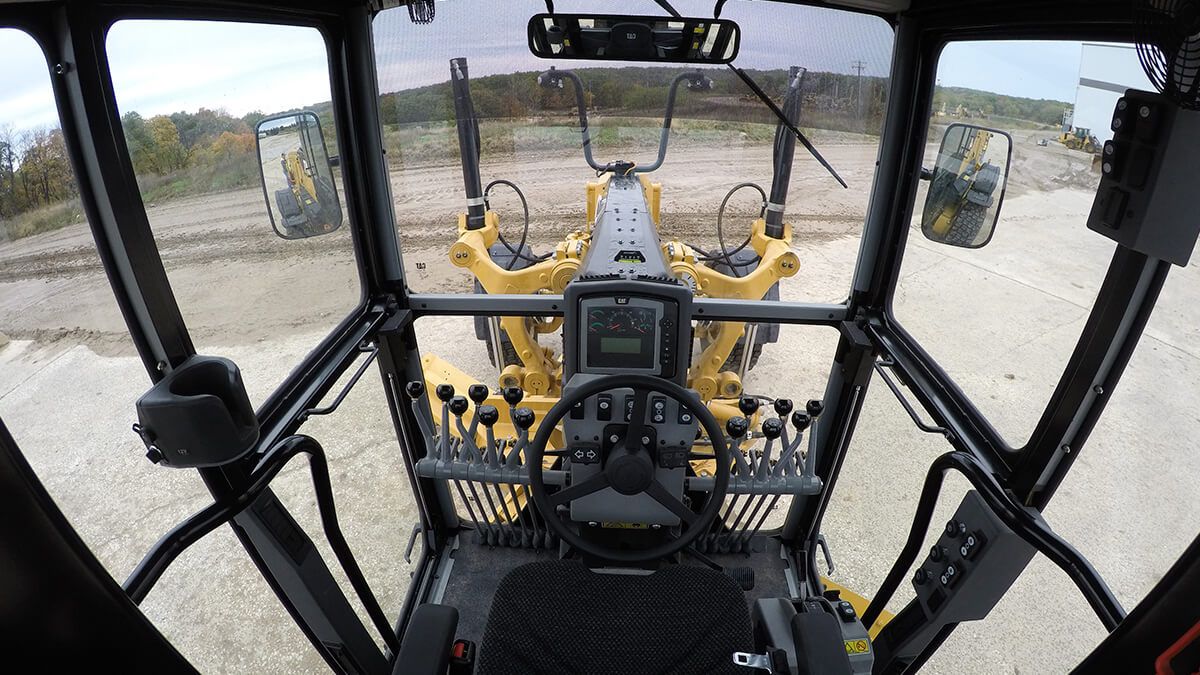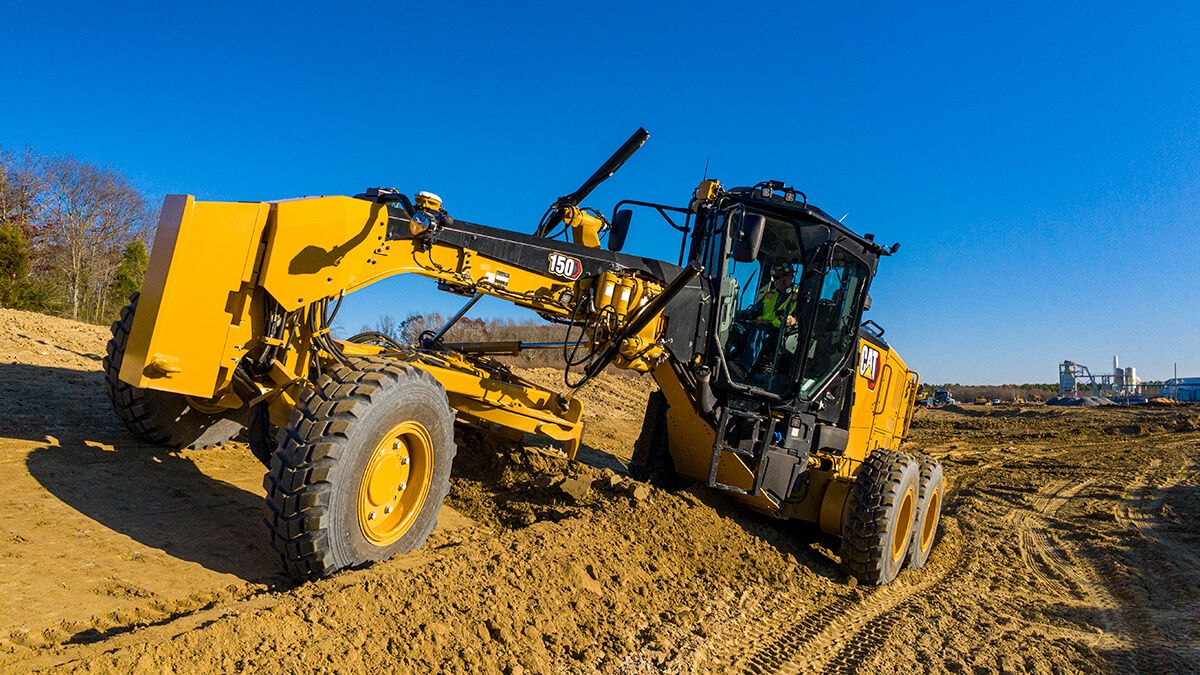

Sign In
Welcome! Sign In to personalize your Cat.com experience
If you already have an existing account with another Cat App, you can use the same account to sign in here
Register Now
One Account. All of Cat.
Your Caterpillar account is the single account you use to log in to select services and applications we offer. Shop for parts and machines online, manage your fleet, go mobile, and more.
Account Information
Site Settings
Security
How to Measure Motor Grader Productivity
Motor grader productivity is an important consideration when you look at jobsite efficiency. Moldboard formulas can help you accurately calculate both productivity and profitability for your Cat® motor grader.
Estimated read time: 4 minutes
Skilled motor grader operation is as much an art as it is a science. That’s why it can be tricky for contractors to get a firm handle on production with these machines.
But getting a handle on your Cat® motor grader operations has many benefits. Doing so can help you better understand machine production and costs — so you can more accurately calculate jobsite productivity and your profitability once the job is complete.
This means getting an accurate idea of how many days you need a motor grader on your job, and how much material that machine can move per day, compared to the required quantity of material that needs to be moved daily to complete the project. This information lets you determine if you need a different size grader (with a larger moldboard) on the jobsite — or if multiple motor graders are a better solution.
GET TO KNOW YOUR MOLDBOARD
There are many different ways to measure a motor grader’s operating capacity or production.
A motor grader’s moldboard angle is calculated by its right angle to the main frame of the machine.
Some good, operational rules of thumb to remember are:
0-degree angle is used for dozing material straight ahead over short distances.
10- to 30-degree angles are used for light, free-flowing materials.
30- to 50-degree angles are preferred for wet, sticky materials, mixing large windrows, ditching and other applications.
Consistent flow off the moldboard requires a steeper blade angle when working material uphill and a reduced blade angle when working material downhill.
Make sure extra material does not flow off the toe of the moldboard when making passes. This can lead to improper material flow and can require additional cleanup passes.
Using a formula that calculates its production in relation to the area covered by its moldboard is one of the most easy and accurate ways to get a firm idea of your grader’s productivity.
PRODUCTION CALCULATION FORMULA
A = S × (Le − Lo) × 5,280 × E (English)
A = S × (Le − Lo) × 1,000 × E (Metric)
Where:
A: Hourly operating area (ft2/h or m2/h)
S: Operating speed (mph or km/h)
Le: Effective blade length (feet or meters)
Lo: Width of overlap (feet or meters)
E: Job efficiency
CALCULATING VARIOUS PARTS OF THE FORMULA
Speeds
Finish grading: 0-2.5 mph (0-4 km/h)
Heavy blading: 0-6 mph (0-9 km/h)
Ditch repair: 0-3 mph (0-5 km/h)
Ripping: 0-3 mph (0-5 km/h)
Road maintenance: 3-9.5 mph (5-16 km/h)
Haul road maintenance: 3-9.5 mph (5-16 km/h)
Snow plowing: 4-13 mph (7-21 km/h)
Snow winging: 9-17 mph (15-28 km/h)
Effective blade length
To calculate effective blade length, bear in mind that the moldboard is usually angled when moving material. Effective blade length must be computed to account for this angle. This is the actual width of material swept by the moldboard.
Moldboard length in feet (meters)
12 (3.658)
14 (4.267)
16 (4.877)
24 (7.315)
Effective length in feet (meters), 30-degree blade angle
10.4 (3.17)
12.1 (3.70)
13.9 (4.22)
20.8 (6.33)
Effective length in feet (meters), 45-degree blade angle
8.5 (2.59)
9.9 (3.02)
11.3 (3.45)
17.0 (5.17)
(For other blade lengths and carry angles: Effective length = COS (Radians (Blade L) 3 Blade Length)
Width of overlap
This is generally 2 ft (0.6 m). This overlap accounts for the need to keep the tires out of the windrow on the return pass.
Job efficiency
This number varies based on job conditions, operator skill and other factors. That said, a good estimation for efficiency is approximately 0.70 to 0.85, but actual operating conditions should be used to determine the best value.
SAMPLE PROBLEM
A Cat motor grader with a 12-foot (8.6-meter) moldboard is performing road maintenance on a township road. The machine is working at an average speed of 8 mph (13 km/h) with a moldboard carry angle of 30 degrees. What is the motor grader’s production based on coverage area?
Note: Due to the long passes involved in road maintenance — fewer turnarounds — a higher job efficiency of 0.90 is chosen.
From the table, the effective blade length is 10.4 ft (3.17 m).
English
Production, A = 8 mph × (10.4 ft − 2.0 ft) × 5,280 × 0.90 = 319,334 ft2/hr (7.33 acres/hr)
Metric
Production, A = 13 km/h × (3.17 m − 0.6 m) × 1,000 × 0.90 = 30,069 m2/hr (3.07 hectares/hr)
Using these formulas will allow you to quickly and easily calculate your motor grader performance.
As always, reach out to your Cat dealer for their expertise and advice in fine-tuning your motor grader operations.
Popular Articles About Motor Graders
Get the most from your motor grader with operating tips, safety advice, maintenance help and much more.
-
Improve Jobsite Safety: Cat® Detect with Smart Camera
Boost visibility from your cab with Cat Detect with Smart Camera.
SEE THE DIFFERENCE -
The Basics of Motor Grader Lever Controls
Don’t get intimidated: Learn motor grader lever controls and work confidently.
START GRADING NOW -
Get Parts and Service Manuals Fast with SIS2GO App
This Cat® parts and service app provides a world of expertise.
SEE MORE -
How To: Cat® Grade with 3D Tips and Techniques
In this video, see how to become a Cat® Grade with 3D pro.
WATCH NOW
Once You Own, You're In
Gain unlimited access to must-know information about your machine. Find ideas you can put to work on the job right away, including business insights.




